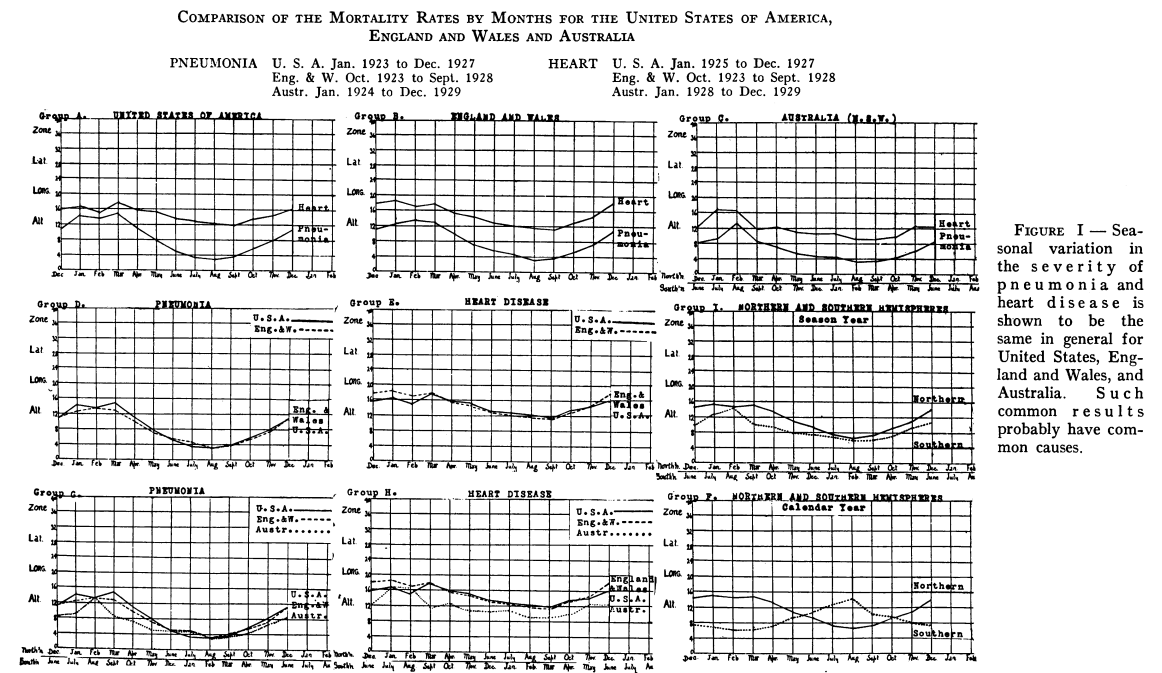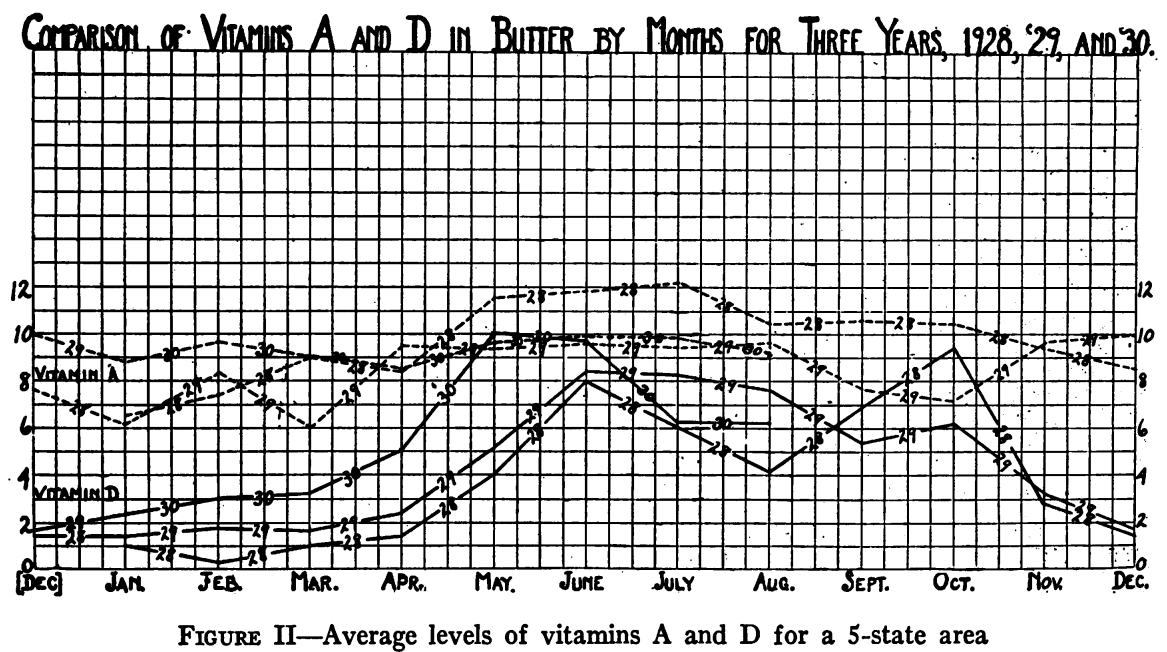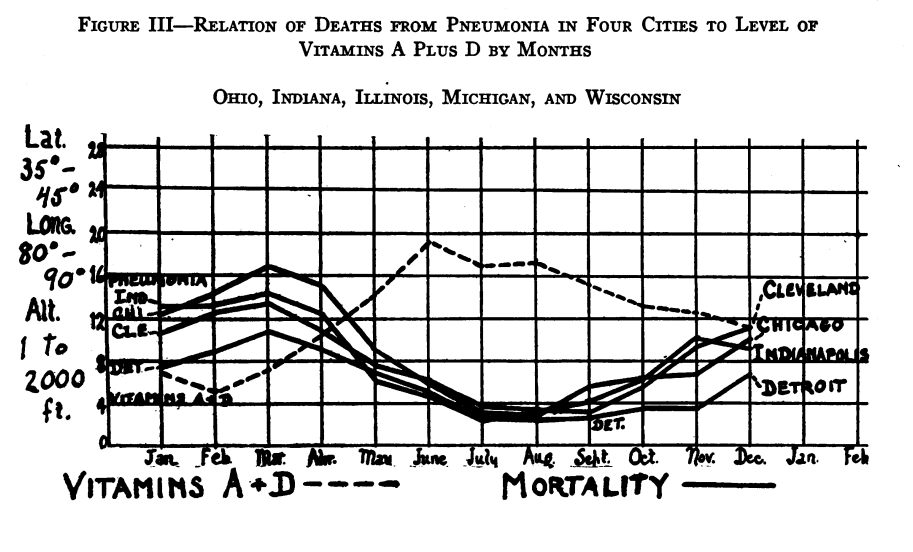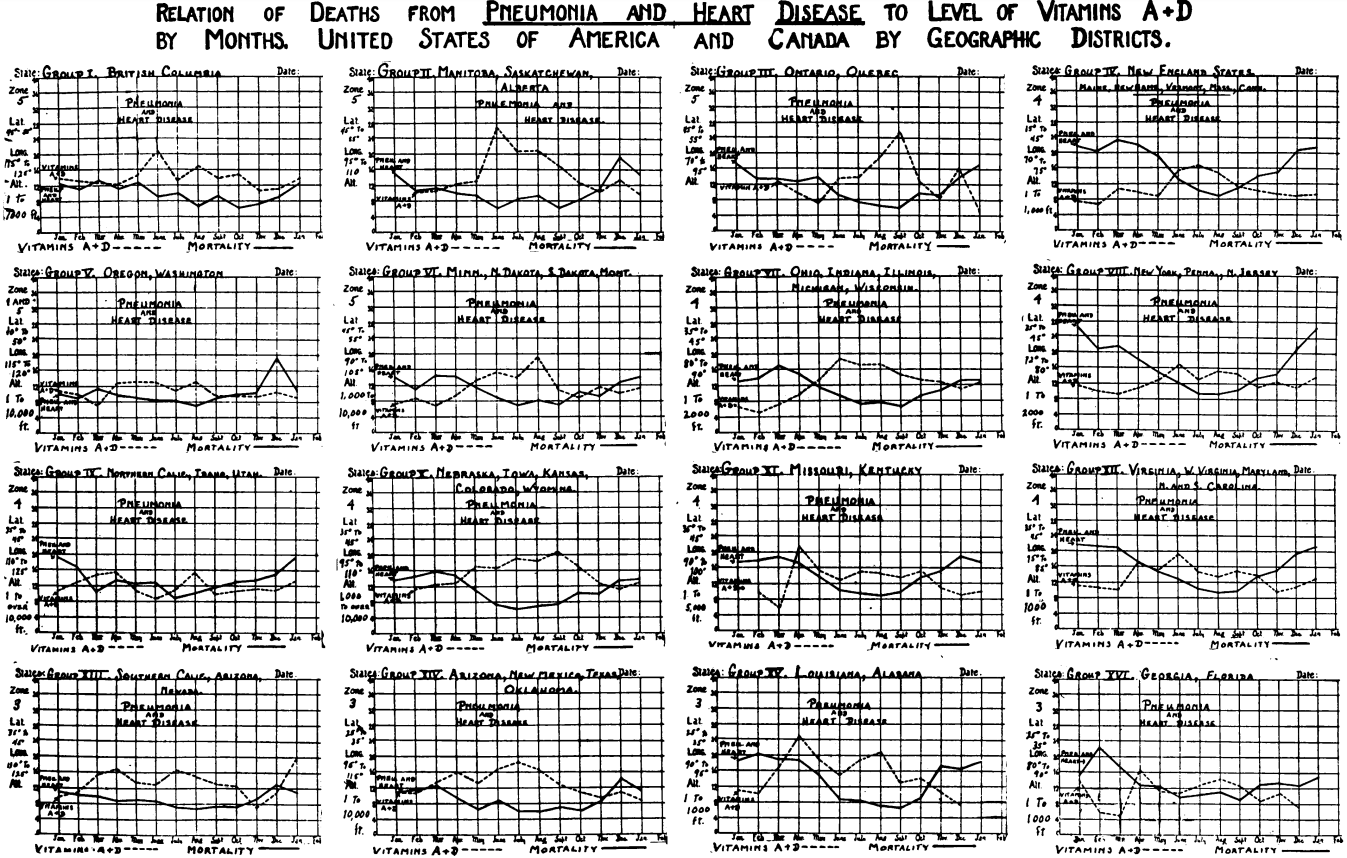Seasonal Variations in Butter-Fat Vitamins and Their Relation to Seasonal Morbidity, Including Dental Caries and Disturbed Calcification
This is another Weston Price study that focuses on the seasonal variation of fat-soluble vitamins and seasonal morbidity. This study came out the year before another Price study on vitamin variation and morbidity.
About fat-soluble vitamins(for Price these were vitamins A,K,D), Price says "These activators have a role which, in some regards, might be compared to that of an ignition system of a gas engine in relation to the utilization of the fuel. The problem has, accordingly, enlarged to include three fundamental factors; namely, inherent characteristics of the individual, contributing overloads and the availability of activators in order that efficient health may be maintained in conjunction with an adequate source of energy food factors."
Price notes: "Many degenerative processes apparently have a cycle of severity or incidence. This is particularly true of skeletal décalcification, one expression of which is familiar to the dental group; namely, the activity of pyorrhea in the destruction of alveolar bone and the development of dental caries. A survey of my clinical records indicates approximately four times as much dental caries in the winter and spring as in the summer and fall." This might have to do with a time-delay effect of increasing length of the day and sun exposure from spring to summer and fall to winter. The effect of sunshine exposure and dental caries was established in the 1930s. The carryover of low vit D from winter to spring would explain what Price notes as a "the increased susceptibility to respiratory infections which occur in the north temperate zone in the winter and spring."
Price notes that "there are cycles in a number of our physical factors has been demonstrated. Seidell and Fenger have shown that the iodin content of thyroid glands of sheep and pigs is about three times as much for the months from June to November as for the months from December to May. Malling-Hansen and others have shown the growth of children to be more rapid in the spring and summer than in the winter."
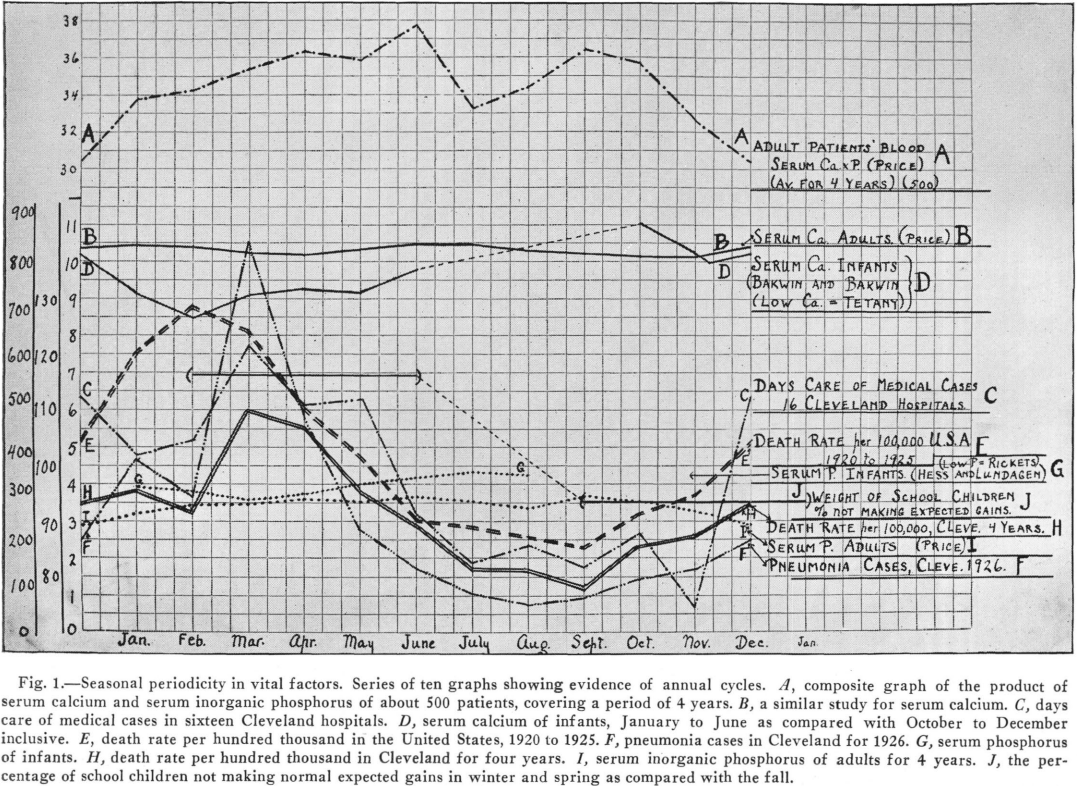
The graph figure shows a seasonal variation in death rate, pneumonia, % of children failing to meet expected weigh gains, and days of medical care in hospitals.
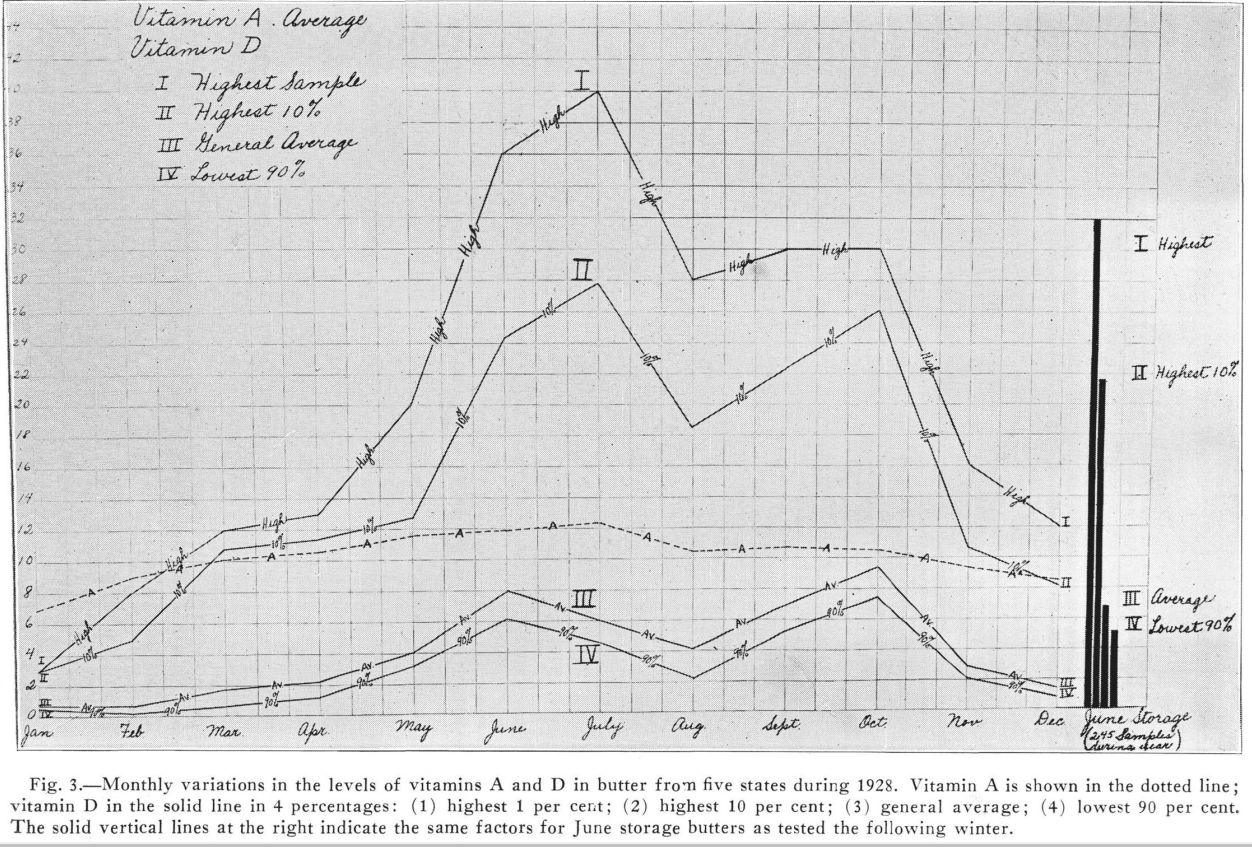
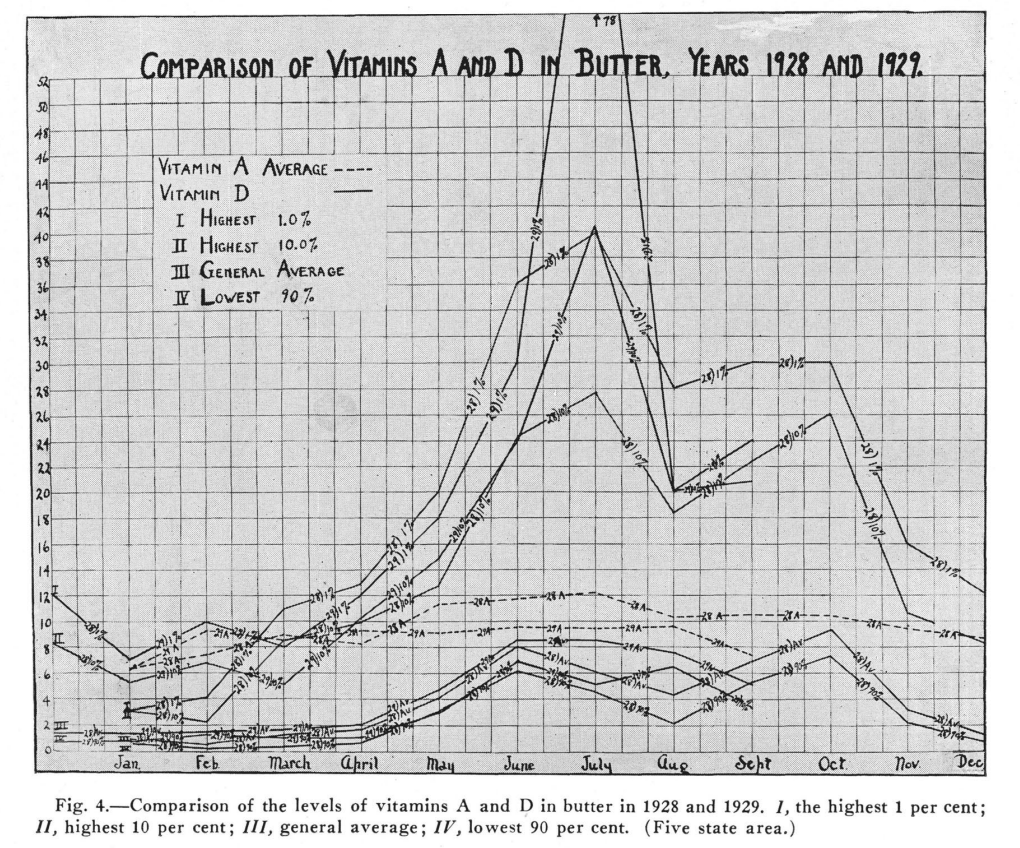
I'm not sure what the y-axis in these figure is. Regardless, the sharp variation in Vit A and D content of milks between highest, 10%, average, and lowest 90% is striking. I'd need to see more data points but I wouldn't be surprised if there is an inequality in vitamin content that mirrors a Boltzmann disitrbution and a Pareto Power Law distribution.
The Boltzmann distribution is an entropy maximizing distribution and high entropy means low temperature or low quality outcomes. In context of milk vitamins, consider that the absolute vast majority of milk comes from dairies who carry a narrow selection of breeds, consume a narrow range of foods and supplements, and whose product value and wealth is often out of their hands and into algorithms- receiving quality gradings and payment determinations from corporate.
This lack of control is why many farmers and ranchers cannot speak out against their exploitation, they do not control their wealth and incomes and this algorithm can be manually changed to retaliate against specific farmers- Morgan Spurlock in Supersize Me 2 encountered this with a chicken farmer. Energy(money/labor) enters and is quickly captured along the controls of the dairy system(corporate structure, feed structure, grazing, transport, etc.) The rigidity and total absorbing nature of these dairies means that there is high entropy(energy bound up and unable to do work) and, subsequently, they are an inefficient conversion of energy(vitamins from plant foods to human-available animal foods).
Additionally, they are inefficient and middling sources of income and profit. Low efficiency of money means wealth accumulation cannot occur, resulting in a continuation of life in the Boltzmann distribution, rather than investing into capital and freedom with profits. In this sense, high entropy dairies produce consistency- consistently poor dairy farmers, consistently poor quality milk, and consistent(slight) variation in vitamin content.
The upper crust(Pareto Power Law) of dairies may be dairies with more control and unique value-forming in their breed types(heritage breeds vs conventional breeds), control in their food(using grass and fruit and vegetable waste rather than corporate-standardized grain and seeds), and greater ability to set prices and control revenue(local market differences, generational wealth permitting freedom of choice, etc). These freedoms mean that there is lower entropy(less rigidity of outcomes and structure) in the system and a more efficient conversion of plant vitamins to animal vitamins.
Dairies that are low entropy can take energy from outside and use it along many different lines without rigidity. Inversely, they can lose it along these lines as well. Bad investments by an hedge fund can be as devastating as bad investments in feed for a dairy. Low-entropy dairies, as shown in the graph, are more variable in their Vit A and D contents, though as a general rule their levels are significantly higher than high-entropy dairies. This is expected as one approaches the upper end of the Boltzmann distribution(with ever lower probabilities of getting and maintaining high vitamin levels)- that is until the dairy moves over to an "autonomous" model where their product quality and outcomes follow the Power Law wherein they can have consistently high quality product that also has high variability.
The Boltzmann dairy can have a high vitamin variation and high vitamin content butter only some of the time and there's a strong chance that next year they'll be making a middling product.
The Power Law dairy has high variation and high vitamin content, can buffer a downward movement of quality(accumulated wealth ie stored Spring grass and high-quality bioavailable supplements), and their variation is mostly upward directed in contrast to the Boltzmann variation- which can go up or down, for the most part equally, though the (econo)thermodynamics will keep most variation pointed down towards lower energy and higher entropy.
This distribution is also found within capitalist economies, ~90% of people have incomes and wealth within a narrow distribution, mostly due to the fact that they accept incomes and wealth rather than setting it; further, their probability distribution is skewed towards a lower energy(less wealth) and higher entropy(less freedom) way of life.
The upper 10% and 1% of society have their wealth and incomes tied to capital and investments, which constitute ownership and an ability to set prices and service value. Thermodynamics and economic temperature relate closely to changes in the economy since the 70s and 80s as communication tech improves product movement and offshoring allows products to be produced in low temperature nations and get sold in high temperature nations. High temp nations have higher incomes, so profit exists so long as there is a temperature difference between the nations.
On the subject of energy vs nutrient density: "We will not readily appreciate the difference in food values of the high and the low samples of butter until we have an opportunity to see the difference in their effect on life. As foods have been, in the past, largely evaluated on their ability to produce energy or their caloric value, they would be relatively equal, but as a means of sustaining life, they are vastly different."



